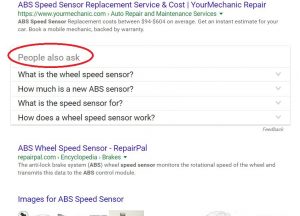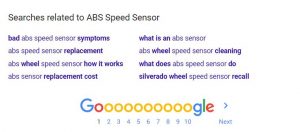Information
Last Updated: 7.10.2017
Contact: [email protected]
- Background
- Style Guide
- Writing tips
- Saving
- Example - Window Vent Visors
- Example - Jeep Commander Blower Motor
- Example - Air Filter
- Example - Accessory Belt Idler Pulley
PartsGeek.com offers very competitive prices on domestic and import auto parts and accessories. Choose from millions of new, OEM, performance, aftermarket, refurbished and rebuilt discount auto parts online from trusted high-quality manufacturers. With shipping from many third party auto parts warehouse manufacturer and vendor locations throughout the United States, you will receive your high-quality auto parts fast. We display the same name brand automotive products just like you would find in all your local auto parts stores. Just check out our large selection of car parts online one time and we are sure you will be back every time.
You will be writing category descriptions for www.partsgeek.com.
The client (PartsGeek.com) is wanting to create new content for their category pages while adding relevant keywords. Remember that with category pages you are not writing about a specific product, but rather the overall category that these products will fit into. They want these category pages written in a natural, conversational tone that broadly describes the product types, uses, benefits and reasons to buy them.
Tone/Voice:
- Informative, helpful, trustworthy, friendly and simple (see Example tabs).
- First person. Write as if you are PartsGeek.com
- Always use PartsGeek.com, never Parts Geek.
- Personalize the copy to the reader by using “your” in reference to the vehicle or its parts.
- Example: “your ride,” “your windshield,” etc.
- Whenever possible, avoid using the word “will” and writing in future tense. Marketing copy is stronger when you instruct the reader to do something now.
- DON’T: When you hit the road, you will turn heads with new diamond-plated mud flaps.
- DO: Hit the road in style and turn heads with a new set of diamond-plated mud flaps from PartsGeek.com.
Keywords:
- Unless otherwise indicated, PartsGeek requires no keywords.
Format:
Layout: Follow the examples found on the Example tabs of this training page. Do not put the URL or the keywords at the top of the Word document. It must follow the exact layout as the Examples.
- Category (Column D of the spreadsheet)
- Introduction – You must mention their 30-day return policy in the intro. You may have 1-3 paragraphs to start the description – see example tabs): Marketing Pitch/Lifestyle Appeal. It is crucial to have a catchy and well-written first sentence. Make the copy relatable. Talk about the benefits of the product/category you are writing about. Talk about why they should order from and trust PartsGeek.com. Mention their 30-day return policy in the intro.
- Question 1 (see examples on coming up with your questions below)
- Answer to question
- Question 2
- Answer to question
- Question 3
- Answer to question
- Question 4 (optional)
- Answer to question
- Two of questions MUST be: What is a ____, and How much is a ____, and the category term on the sheet needs to be used with both.
Follow these steps to come up with your questions:
- Type your Category term (Column D of the spreadsheet) into Google and click search.
- Scroll down the search results page until you see the “People also ask” section. There are typically 3-4 questions. Not every category term you search will have the “People also ask” section. If this is the case for category term, come up with your own questions but be sure to include the following two questions:
- What are/is (category term)?
- How much is/are new (category term)?
- Choose your own question
- Choose your own question (this is optional, it depends on if you need more copy to meet your word count minimum or not)
This is what the “People also ask” section looks like for the category term “ABS Speed Sensor”:

If you need ideas on what other questions to come up with aside from the mandatory 2 questions listed above, perform a Google search on your category term, scroll all the way to the bottom of the page and there is a “Searches related to (category term” section. Looks at these terms and often times you can come up with a question based on these related terms. For example, if we do a search on “ABS Speed Sensor”, these are the results for the “Searches related to ABS Speed Sensor”:

Looking at these terms, I came up with the following 2 questions I could use:
- What do ABS Speed Sensors do?
- How do I Clean ABS Speed Sensors?
Writing tip: The following steps have been helpful to writers when writing these descriptions:
- Write the questions section – They are pretty easy to find answers to.
- The current description on the description page (URL in column C) has a lot of the info you would need for the “What is it” question.
- Write the 2nd paragraph – Talk about the brands that they could choose from, the 30-day return policy, and tout the fact that PartsGeek.com has millions of products for cheap prices, etc.
- Write the 1st paragraph – Revamp the remaining copy from the current description and use marketing copy language to craft the first couple of sentences, a quick recap of what it is and why it’s important and why they need it.
- The content needs to be converted to HTML before being submitted.
- Steps to convert content from Word to HTML:
- Go to http://wordtohtml.net/
- Copy/Paste your description into the left side of the screen and it will automatically convert to HTML on the right side of the screen
- Copy/Paste the converted text from the right side of the screen into your Word doc and save it.
- Steps to convert content from Word to HTML:
- You will be submitting the content two ways:
- Google Form: Parts Geek Google Form
- Category term – copy/paste category term in column D of the spreadsheet
- Category Description – copy/paste your category description from your Word document into this section
- Only submit the HTML format through the Google Form
- Email
- Save your Word document as the Category term (column D)
- Put Parts Geek in the subject line of the email and send to [email protected]
- Submit the original (non-HTML) format to the Submit box
- Google Form: Parts Geek Google Form
This is what the content will look like on the website.
Window Vent Visors
Few things are more exhilarating than fresh air and the open road. Our window vent visors allow you to drive with the windows down—even at highway speeds. The contoured design of each set reduces noisy, tumultuous airflow to nothing more than a quiet breeze. Our car window rain guards keep other elements of nature out of your cabin as well. Roll down the windows and enjoy the renewing scent of a spring rainstorm or the bracing briskness of the first winter snow without getting wet.
At PartsGeek.com, we offer a wide selection of vent visors from leading manufacturers such as Putco and Auto Ventshade, all at competitive prices. Our fit guide makes it easy to find the perfect set for your make and model, and you can shop with confidence knowing that your purchase is backed by our 30-day return policy.
What are window vent visors?
Window visors, sometimes referred to as window deflectors or car window rain guards, are aftermarket accessories that attach to the driver-side and passenger windows. The visors diminish wind turbulence and prevent rain, bugs, dust and road debris from entering your vehicle when the window is partially rolled down. Tinted designs are available to decrease heat and sun glare inside your ride.
How much do new window vent visors cost?
Window visors are some of the most affordable aftermarket accessories on the market. Most cost between $35 to $50 on PartsGeek.com. The exact price depends on several factors, including:
- How many pieces are included in the set
- Year, make and model of the vehicle the set is designed to fit
- Type of material used
- Brand
How do I install window vent visors?
There are two main types of window visors: adhesive and in-channel. Both are easy to install by following the directions below.
Adhesive Window Vent Installation
- Use alcohol or an automotive cleaner to remove any dust or dirt from the area where the adhesive foam tape will be applied. This enables a stronger bond.
- Allow the surface to dry.
- Remove the backing strip from the adhesive, exposing just a few inches. Use caution not to touch the adhesive.
- Temporarily secure the visor in place using the exposed adhesive.
- Step away from the vehicle, checking that the deflector matches your vehicle’s silhouette.
- Make any necessary adjustments, then slowly remove the remainder of the backing strip, pressing firmly to secure the visor in place as you go.
In-Channel Window Vent Installation
- Clean windows and channels using an automotive surface cleaner or alcohol.
- Allow to fully dry.
- If the in-channel visors have an adhesive strip for a more secure installation, remove the backing.
- With windows rolled down, insert the front lip of the deflector into the front of the window channel.
- Create tension by bending the deflector towards yourself, then slip the rear lip into the rear window channel.
- Roll up the windows to completely secure the visors.
Jeep Commander Blower Motor
Keep your Jeep Commander’s HVAC system in optimal shape by replacing the blower motor. An old blower motor can be finicky and less efficient. You might notice your air conditioner isn’t blowing cold air, the fan isn’t working at all, or strange sounds are coming from the blower. Whatever the case is, the blower motor is the heart of your Jeep’s HVAC system and keeps everything running smoothly according to your climate settings.
PartsGeek.com carries the best Jeep Commander blower motors on the market. Whether you need OEM or aftermarket blower motors, you can find the right one. With top brands like Mopar, Four Seasons, TYC, GPD, and VDO, your HVAC unit will be working optimally in no time. If you’re ever the tiniest bit hesitant about your purchase, you can be confident with our 30-day return policy.
What is a Jeep Commander blower motor?
The blower motor keeps your Commander’s HVAC system blowing hot or cold air, according to your settings. When voltage is sent to the electric blower motor, it spins and causes the fan to spin. Depending on your climate settings, the fan is directed to blow through an air conditioning evaporator or heater core.
How much is a Jeep Commander blower motor?
A Jeep Commander blower motor can be anywhere between $30 to upwards of $200. This price range is due to the variety of brands, from OEM to aftermarket. The price also depends on the year of your Commander and any additional features.
When should I replace a Jeep Commander blower motor?
You should consider replacing the blower motor if you notice:
- Abnormal noises
- No air blowing
- A faulty resistor
How long does a Jeep Commander blower motor last?
The blower motor can potentially last for the life of your Jeep. Sometimes the motor wears out within a few years if the HVAC system is not properly maintained or cleaned.
Air Filter
Nobody likes to breathe in dust particles and toxins, including your vehicle. A car or truck that allows too many contaminants into the engine will see a decline in performance. Take care of your vehicle the same way you would take care of your body by investing in a high-quality air filter.
Filters are vital components of your vehicle’s intake system. Although they are small and simple in design, they help ensure that the precise mixture of air and fuel enter your intake system so that you can enjoy peak engine performance. Not only do dust and dirt throw off that balanced mixture, but they can also cause corrosion. For this reason, you’ll want to make sure you replace your filter regularly.
Here at PartsGeek.com you can select air filters from top brands such as Hastings, WIX, Fram, Hengst, AC Delco, K&N, Mann, Beck Arnley, Motorcraft, AFE and Denso. We pride ourselves in offering a wide variety of auto parts, exceptional customer service and fast delivery. We also have a 30-day return policy to ensure that you can shop with confidence and find just the right air filter for your needs.
What is an automotive air filter?
A filter is a pleated piece of fabric, paper or cotton that is placed in front of the intake manifold. It filters out debris, dust and contaminants to boost your car performance and fuel efficiency. It also helps to reduce damage from corrosion.
How much is an air filter?
The price of an air filter is subject to a number of different factors:
- The year, make and model of the vehicle you drive
- The brand of the air filter
- The level of filtration desired
- Additional air filter features included
That being said, most of the air filters on PartsGeek.com fall between the $10 to $25 range.
How often should you change your air filter?
Most air filters should be replaced between 15,000 to 30,000 miles. This depends on the year, make and model of your vehicle as well as the driving conditions. If you don’t do a lot of driving, a good rule of thumb is to replace your filter every three years. If you do a lot of driving on unpaved roads, you’ll probably need to replace your filters more often. Air filters become more brittle as they age, so you don’t want to leave it unattended for too long. A good habit is to check your filter every time you get your oil changed.
Accessory Belt Idler Pulley
Keep your vehicle’s accessory belt in tip-top shape with the help of durable, high-performing idler pulleys. Now, you might be wondering why you would need high-quality idler pulleys when they don’t actually drive anything in the engine. The fact is that these dumb pulleys help your accessory belt make some elaborate twists and turns to reach all the crucial accessories in your vehicle. These accessories include the alternator, water pump, air conditioning compressor, power steering pump, among others. An idler pulley that falls out of working order can cause the accessory belt to come off track which can seriously affect other important parts of your engine that are much more expensive to repair and replace. Installing the finest dummy idler pulleys can go a long way to ensure your auto investment lives up to your expectations.
Here at PartsGeek.com, we offer some of the best accessory belt idler pulley parts on the market. Whether you’re looking for OEM, refurbished, aftermarket or rebuilt idler pulleys, we’ve got the variety you’re looking for. To top it off, we also offer a 30-day return policy to ensure that you’re happy with your purchase. Browse our selection of accessory belt idler pulleys below:
What is an accessory belt idler pulley?
Accessory belts (or serpentine belts) are responsible for driving multiple peripheral accessories in an engine, including the power steering pump, alternator, water pump and air conditioning compressor. An idler pulley is an engine pulley that helps to guide and tension the belt as it weaves its way around these accessories. These pulleys are usually made from either metal or plastic and have a pressed bearing to keep them secure on the shaft of the belt.
How much is an accessory belt idler pulley?
Most accessory belt idler pulleys cost between $20 and $70 here at PartsGeek.com. However, the cost of the pulley will depend on what part of the engine it’s attached to, the year, make and model of the vehicle it is for, the type of material it’s made from as well as the brand that makes it.
How long does an idler pulley last?
An idler pulley is designed to last the lifespan of the car. However, this pulley can wear out from use and will need to be replaced.
When should I replace my idler pulley?
Here are some of the systems of a bad idler pulley that needs to be replaced:
- The engine warning light comes on
- The power steering shuts off
- The engine will overheat on a regular basis
- You might hear squeaking and screeching noises coming from under your hood
